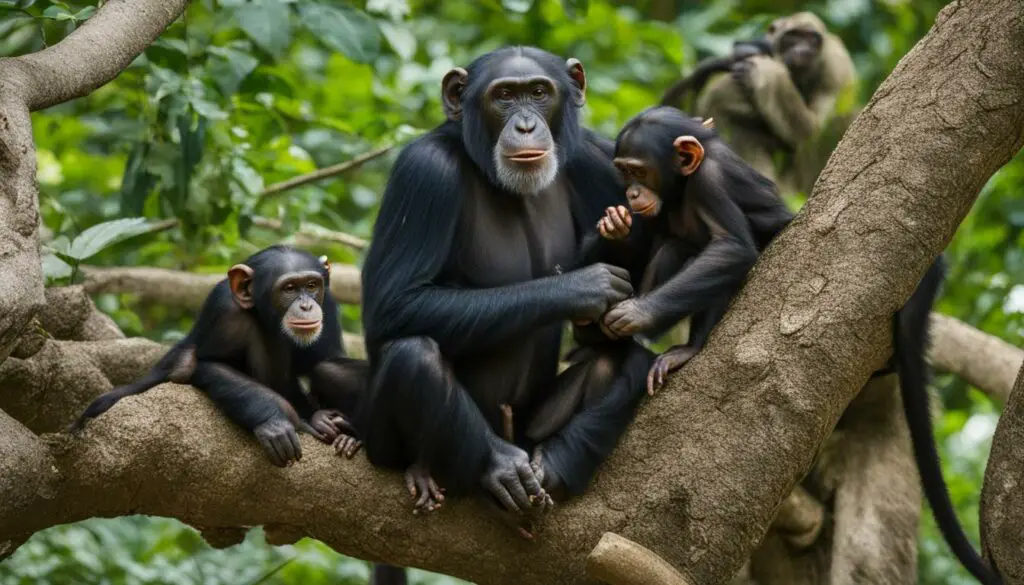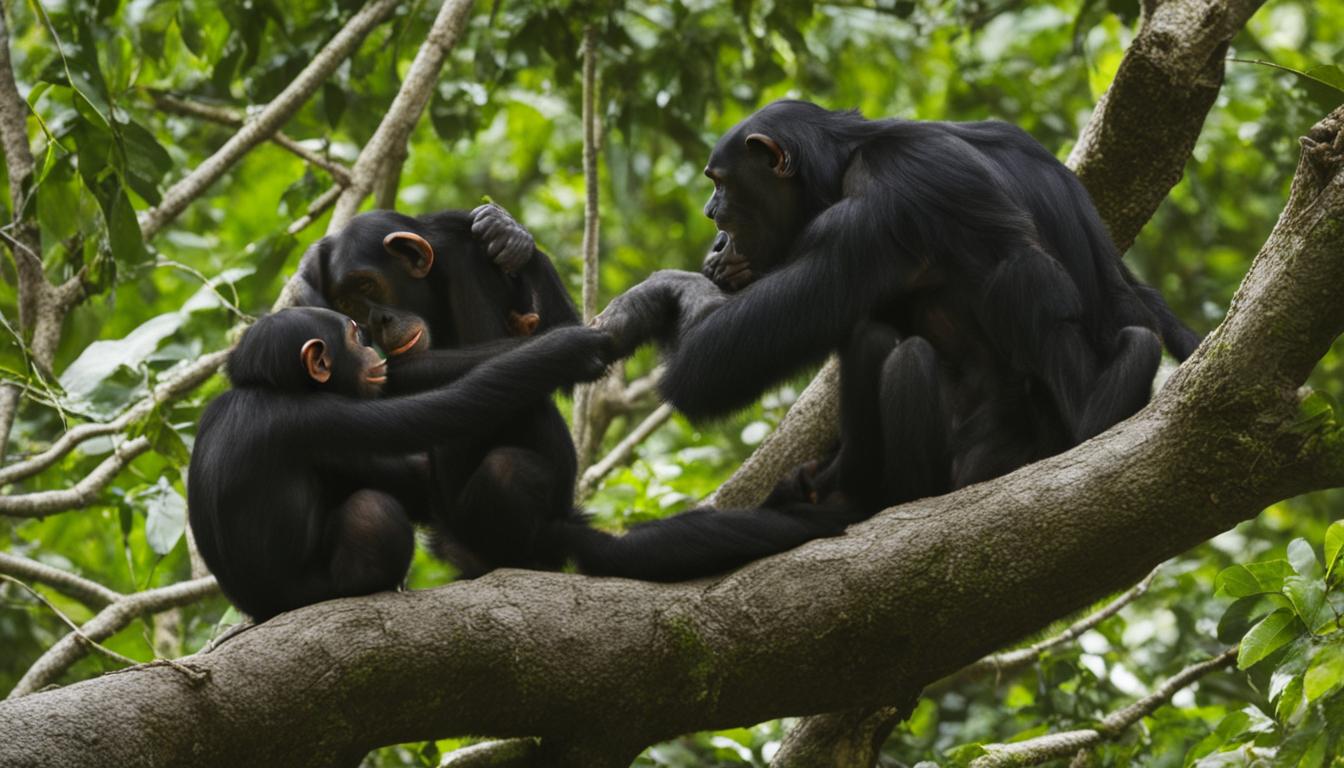If you’ve ever wondered about the intricate process of raising chimpanzee offspring, this article will provide you with valuable insights. It’s fascinating to learn about the care and nurturing that goes into raising baby chimpanzees. From the early stages of carrying the newborns to their exploration and development milestones, chimpanzee parenting is a fascinating journey.
Chimpanzee mothers give birth to one baby at a time and carry them under their bellies for the first month, ensuring easy access to breastfeeding. As the baby grows, the mother allows them to explore their surroundings and interact with play partners. Throughout this period, the mother remains in close proximity, providing necessary guidance and protection.
The weaning process typically occurs around four years of age when the mother becomes pregnant again. During this time, the young chimpanzee learns vital skills such as identifying safe foods, understanding the dynamics of their troop, and even using tools. It is a gradual process where the mother gradually fosters independence in her offspring, eventually allowing them to fend for themselves.
Rearing chimpanzee babies involves a delicate balance of maternal care, socialization, and skill development. The young chimpanzees depend on their mothers for at least two years, gradually becoming more independent as they grow older. As the older sibling, they learn from play partners and acquire essential skills like foraging, tool use, communication, and social behavior.
In the sections that follow, we will delve deeper into various aspects of raising chimpanzee offspring, including breeding and gestation, maternal care and development, learning and skill development, birth mechanisms, and a comparative analysis with human birth.
Chimpanzee Breeding and Gestation
Chimpanzees breed throughout the year whenever a female comes into season. Female chimpanzees have menstrual cycles and come into estrus approximately every 36 days unless they are pregnant. Gestation in chimpanzees lasts for about 8 months. Females give birth approximately every three to four years. Twins are rare, and usually, only one baby is born. It is common for first-time mothers to take some time to learn how to care for their newborns. The baby is carried by the mother for the first 5 months, and by the age of one year, it can walk and weighs around 9kg.
Maternal Care and Development
Maternal care plays a crucial role in the development of young chimpanzees. These infants depend on their mothers for at least two years, requiring their constant guidance and support. During the first few months of life, chimpanzee babies are carried everywhere by their mothers, providing them with a sense of security and nourishment. This close physical contact strengthens the bond between mother and baby, fostering emotional attachment and ensuring the infant’s well-being.
As the baby chimpanzees grow older, they begin to explore their surroundings and gradually gain independence. At around six months, they take their first steps, venturing away from their mothers for short periods. However, they still spend the majority of their time in close proximity to their mothers, who remain their primary source of comfort and protection.
Around the age of four, when the mother gives birth to another baby, the older sibling must learn to fend for itself and navigate the world without constant maternal care. This period of transition is an essential part of their development as they learn to socialize with other chimpanzees of similar age and navigate their troop dynamics.
During this time, older siblings have opportunities to interact with play partners, engaging in social activities that contribute to their cognitive and physical development. As they spend time with peers, they learn important skills such as locating food sources, playing, and exhibiting appropriate behaviors within the troop hierarchy. These interactions enhance their socialization abilities and prepare them for adulthood.
It is through maternal care and the development milestones they go through that young chimpanzees acquire the essential skills needed for survival and successful integration into their social groups. This process sets the foundation for their lifelong learning and behavior patterns.
| Development Milestones | Description |
|---|---|
| Physical Independence | At around six months, chimpanzee babies start walking and exploring their surroundings, gaining physical independence. |
| Socialization | As they grow older, young chimpanzees socialize with peers, learning important skills and behaviors within their troop. |
| Play Partners | Interaction with play partners helps improve cognitive and physical abilities, aiding in their overall development. |
| Maternal Bond | The strong bond formed with their mothers during early development provides emotional support and a sense of security. |
Learning and Skill Development
The learning process is a crucial aspect of chimpanzee offspring development. From a young age, they engage in skill acquisition that equips them with the necessary tools for survival. Let’s explore the key areas of learning and skill development in chimpanzees.
Foraging:
Chimpanzees learn to navigate their environment in search of food sources. They acquire knowledge about which fruits and plants are safe to eat and develop strategies for successful foraging. Through observation and trial and error, young chimpanzees hone their foraging skills, ensuring their sustenance in the wild.
Tool Use:
Chimpanzees are renowned for their ability to use tools in various contexts. Young chimps learn how to create and utilize tools to accomplish specific tasks, such as cracking nuts, collecting termites from mounds, or fishing for insects. This skill acquisition is passed down through generations, with older individuals teaching the younger ones the intricacies of tool manipulation.
Communication:
Effective communication is vital for chimpanzees’ social and cooperative behavior. Young chimps learn to use vocalizations, gestures, and facial expressions to convey messages and establish relationships with their troop members. They observe and imitate the communication patterns exhibited by older individuals, gradually refining their communication skills over time.
Social Behavior:
Chimpanzees are highly social animals, and understanding social dynamics is essential for successful integration within the troop. Young chimpanzees learn the intricacies of social hierarchies, behavior norms, and group dynamics. Through play and interaction with other members, they acquire the necessary social skills to navigate the complex social structures of their community.
Overall, the learning process in chimpanzees encompasses a wide range of skills, including foraging, tool use, communication, and social behavior. Through observation, imitation, and hands-on experience, young chimps acquire the knowledge and abilities necessary for survival and integration within their troop.

| Skill | Description |
|---|---|
| Foraging | Chimpanzees learn to identify safe food sources and develop strategies for successful foraging. |
| Tool Use | Young chimps acquire the ability to create and use tools for various tasks, such as obtaining food. |
| Communication | Chimpanzees develop communication skills through vocalizations, gestures, and facial expressions. |
| Social Behavior | Youth learn social hierarchies, behavior norms, and group dynamics to navigate the chimpanzee community. |
Birth Mechanism and Orientation
When it comes to chimpanzee birth, the mechanism and orientation may differ from what one might expect. Unlike humans, chimpanzee babies emerge with an occiput anterior orientation, meaning their face is oriented in the opposite direction to their mother’s. After the baby’s head has emerged from the birth canal, the head and body then undergo rotation. This observation challenges the notion that the mechanism of birth in chimpanzees is similar to that of humans, shedding light on the uniqueness of each species’ birth process.
Interestingly, some newborn chimpanzees are capable of landing on the ground independently, without assistance from the mother. This occurrence further emphasizes the distinctness of chimpanzee birth in comparison to our understanding of human birth. It is important to consider these observations and reassess the commonly held belief that human birth mechanism is exclusive and unparalleled.
Through these insights into chimpanzee birth, we gain a deeper understanding of the intricate mechanisms involved in the delivery of these remarkable creatures. The occiput anterior orientation and foetal rotation demonstrate the dynamic nature of birth among chimpanzees, offering an intriguing perspective on their reproductive journey.
Comparative Analysis and Evolution
Comparative analysis of birth in non-human primates, such as chimpanzees, provides valuable insights into the unique aspects of human birth. Recent observations of chimpanzee births have revealed striking similarities in the orientation and rotation of the baby’s head during the birthing process, akin to human births. This challenges the long-standing belief that human birth mechanisms are entirely unique and distinct from other primates.
This comparative analysis between chimpanzee and human birth mechanisms raises intriguing questions about the necessity of modern human midwifery practices. With similarities observed in the orientation and rotation of the baby’s head, the role and significance of interventions during childbirth come into question.
Further research and in-depth comparative analysis are required to fully grasp the evolutionary implications and understand the intricate scenario of human birth. By studying non-human primates, we can gain a comprehensive perspective on the evolution and development of birth processes, shedding light on the factors that shaped human uniqueness in this aspect and challenging conventional notions of human childbirth.
What role do chimpanzee offspring play in the mating and reproduction process of chimpanzees in the wild?
Young chimpanzees play a crucial role in the mating and reproduction process of chimpanzees in the wild. They learn important skills and behaviors by observing adult chimpanzees engaging in courtship and mating rituals. This early exposure to chimpanzee mating behavior helps them prepare for their own reproductive journeys in the future.
Is the process of raising chimpanzee offspring similar to the mating and reproduction process of gorillas in the wild?
The process of raising chimpanzee offspring is quite different from the gorillas mating and reproduction process in the wild. While chimpanzees live in social groups with a dominant male and multiple females, gorillas have a more structured and stable family unit led by a dominant silverback male.










